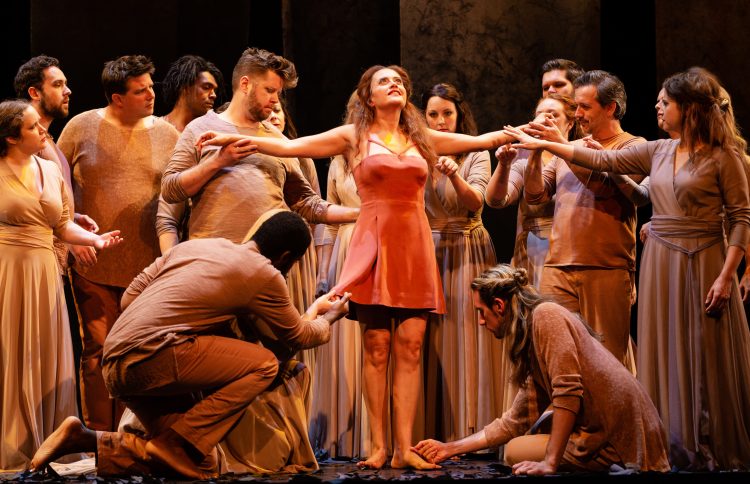
The Opera Philadelphia production of Semele is a musical treat.
Philadelphia, of course, is a center of education and culture. But for more than a century, companies in that city avoided the operas of Georg Frideric Handel. He was born the same year as Bach, but Handel’s work was neglected even during the decades when Leopold Stokowski’s Bach transcriptions were frequently played at Philadelphia Orchestra concerts.
When Handel operas had a resurgence in Europe and New York in the twentieth century, this city’s companies still shied away from them. Opera Philadelphia, therefore, deserves praise for mounting this ambitious production as part of its O19 Festival. The singing is superb, although the visual production is controversial.
Twice within a week, as the O19 Festival overlapped with the Fringe Festival, I attended dramas based on Greek mythology. First was The Iliad, an English-language play that retold Homer’s epic about the Trojan War; then this 1744 opera based on Greek myths (although Handel’s libretto uses the later Roman names, such as Jupiter instead of Zeus.)
According to the Greek legend, Semele, the daughter of Cadmus, the king of Thebes, was a woman who rejected her fiancee and had an affair with the king of the gods, then died while pregnant with his child. She was doomed by her own ambition and pride. As the opera starts, Cadmus has arranged for her to marry Athamas, the prince of Boeotia. But she calls off the ceremony because she yearns for Jupiter, who appears in the form of an eagle and carries her off. Meanwhile, Semele’s sister Ino is in love with Athamus.
Jupiter’s wife Juno is angered by Semele’s affair with her husband, so she disguises herself as Ino and advises Semele to insist that Jupiter appear to her in his real form, and that will make her immortal like him. When he does that, Semele is consumed by fire. The unborn child of Semele and Jupiter arises from her ashes. He is Bacchus, god of wine, and the chorus sings “Happy, happy shall we be.”
As you see, it’s a complicated story, and Handel’s music, beautiful as it is, provides little help in understanding what’s going on. The words of his arias are brief expressions, repeated multiple times, of the character’s feelings. Unlike modern musical theater which aims to have the singer change action during the course of a song, Handel’s arias set a mood and reinforce it, without advancing or changing the plot.
In this production by the fashionable Los Angeles director James Darrah the singing and orchestral playing are on a high level, and they’re augmented by balletic movements that visually elaborate on the music. The choreography by Gustavo Ramirez Sansano has prominence like Jerome Robbins’s in West Side Story. This is a worthwhile ambition, but Sansano’s work is too interventionist, often overshadowing the music. It does not make the narrative clear.
Dancer Lindsey Matheis is employed as a mirror double of Ino, expressing that character’s feelings. She contorts her body like a gymnast while other dancers writhe on the floor and wave their arms.
Gary Thor Wedow, who has conducted the New York Philharmonic in Handel’s Messiah, leads a stylish performance by locally-based instrumentalists. His orchestra includes period instruments, such as theorbo and harpsichord, and has extra woodwinds placed in a proscenium box to our left while a percussionist is in a box to the right, portraying the thunderbolts of Jupiter. Elizabeth Braden coaches a chorale of twenty in the intricate polyphonic choruses.
All of the singers use assertive projection, in contrast to the reserved style of Handel’s religious music. Yet they never force. Their articulation and ornamentation are excellent.
In particular, soprano Amanda Forsythe is a revelation as Semele. Her lyric passages have limpid beauty while her dramatic ones have dashing agility. Her breath control is magnificent. Forsythe is enchanting in the Mirror aria, “Myself I shall adore,” where she imagines that she’s as beautiful as any of the gods.
Mezzo-soprano Daniela Mack brings power to her two roles of Juno and Ino, with more majesty than required in her fine previous appearances as Carmen, Elizabeth Cree, and (in Santa Fe) as Bradamante in Handel’s Alcina. Her dramatic rendition of “Iris, hence away” is a standout.
Mack’s real-life husband, tenor Alek Shrader shows a nice affinity for Handel. I’ve seen him in Italian, German and American roles (most recently as a mis-directed Candide) and I’m convinced that he should spend more time in the Handelian repertoire. His lyric voice soars as the lascivious Jupiter and his “Where’er you walk” is lovely.
The British countertenor Tim Mead spins florid beauty of tone as Athamus. The bearded bass Alex Rosen impresses as a robust Cadmus and as the somnolent Somnus, the god of sleep. Soprano Sarah Shafer does her most sparkling work to date in the role of Juno’s messenger.
The score has been trimmed for this production, and the editing creates a problem for devotees of Handel. The showiest aria for Athamas has been transferred from the last act to the first. And a section of the prison scene from Handel’s Theodora, “Oh that I on wings could rise,” is interpolated into Semele’s role. Of course, the newbie listener won’t notice this. Major institutions have muddied the waters. They often treat arias as interchangeable items. They have shamelessly gathered Baroque arias by disparate composers and shoved them into pastiche productions. Remember the Metropolitan’s Enchanted Island in 2012?
Originally published in The Opera Critic, the international website for professional musicians.